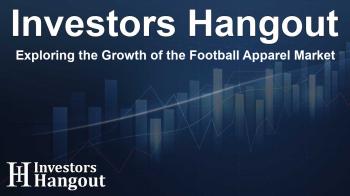Exploring the Growth of the Football Apparel Market

The Football Apparel Market's Transformative Growth
The global football apparel market is experiencing remarkable growth, projected to increase by USD 3.66 billion between 2025 and 2029. This surge is driven by a variety of factors, including the rising demand for jerseys worn by celebrity football players, increased brand endorsements, and effective marketing strategies from leading companies. This comprehensive overview not only highlights current trends but also delves into future prospects in the expanding football apparel landscape.
Market Overview and Dynamics
According to various market analyses, the football apparel market is expected to grow at a compound annual growth rate (CAGR) of 5.8% throughout the forecast period. Several key players, such as Adidas AG, Nike Inc., and PUMA SE, are leading this market, introducing innovative products that cater to a wide range of consumers. The popularity of football continues to drive merchandise sales, with clubs capitalizing on their branding and fan engagement initiatives.
Key Growth Drivers
One major factor contributing to the market's growth is the increased ease and convenience of online shopping. Consumers now prefer to purchase their favorite teams’ apparel online, especially with the enhancements brought by digital technologies like augmented reality (AR). This feature allows prospective buyers to visualize how certain apparel might look on them before making a purchase.
Moreover, eco-friendly products have captured the attention of environmentally-conscious consumers. Brands are taking the initiative to create sustainable football kits using materials like recycled polyester and organic cotton, enhancing their market appeal. These innovative approaches help attract a wider customer base that values sustainability.
Challenges Facing the Market
Despite robust growth prospects, the football apparel market faces notable challenges. The rise in counterfeit products poses a significant threat to brand integrity and consumer trust. Recent reports of extensive raids, where authorities seized counterfeit sports merchandise worth millions, have raised alarms among manufacturers and customers alike. Tackling this issue requires increased efforts in enforcement from authorities and educational initiatives aimed at consumers.
Additionally, fluctuating raw material prices and the demand for eco-friendly alternatives can impact the overall profitability of leading brands. Companies need to continually adapt to meet these changing dynamics to retain their competitive edge.
Emerging Trends in the Market
The influence of celebrity endorsements continues to play a crucial role in shaping consumer purchasing behaviour. Football apparel manufacturers are harnessing the fame of well-known players to boost sales. For example, Nike has established annual contracts worth millions with top athletes to leverage their popularity, demonstrating how alliances with leading sports figures can drive revenue.
Market Segmentation Overview
The football apparel market can be categorized based on application, product type, and geography. The primary applications include professional and amateur players, while product categories encompass shirts and shorts specifically designed for the sport.
Geographically, the market exhibits diversity, with regions like Europe playing a prominent role in sales, often contributing up to 55% of the total market share. Other important regions include North America, South America, and parts of the Asia-Pacific, each presenting unique growth opportunities.
The Future of Football Apparel
As the landscape of the football apparel market evolves, organizations remain focused on understanding consumer preferences and leveraging technological advancements. Insights from comprehensive market research provide valuable information that helps stakeholders identify opportunities and challenges inherent in this dynamic sector.
With the continued rise of social media, digital marketing campaigns will likely become increasingly pivotal. Brands will harness platforms to create buzz around special collections, engage with fans directly, and drive sales through targeted promotions.
Frequently Asked Questions
What is the projected growth of the football apparel market?
The football apparel market is projected to grow by USD 3.66 billion from 2025 to 2029 at a CAGR of 5.8%.
What factors are driving the growth of the football apparel market?
Key drivers include increased online shopping convenience, celebrity endorsements, and a growing demand for eco-friendly products.
What challenges does the football apparel market face?
The prevalence of counterfeit products and fluctuating raw material costs are significant challenges facing the market.
How significant are celebrity endorsements in this market?
Celebrity endorsements play a crucial role by significantly influencing consumer purchasing decisions and enhancing brand visibility.
What regions contribute most to the football apparel market?
Europe leads in market contribution, followed by North America and certain Asia-Pacific regions, each offering unique growth potential.
About Investors Hangout
Investors Hangout is a leading online stock forum for financial discussion and learning, offering a wide range of free tools and resources. It draws in traders of all levels, who exchange market knowledge, investigate trading tactics, and keep an eye on industry developments in real time. Featuring financial articles, stock message boards, quotes, charts, company profiles, and live news updates. Through cooperative learning and a wealth of informational resources, it helps users from novices creating their first portfolios to experts honing their techniques. Join Investors Hangout today: https://investorshangout.com/
Disclaimer: The content of this article is solely for general informational purposes only; it does not represent legal, financial, or investment advice. Investors Hangout does not offer financial advice; the author is not a licensed financial advisor. Consult a qualified advisor before making any financial or investment decisions based on this article. The author's interpretation of publicly available data presented here; as a result, they should not be taken as advice to purchase, sell, or hold any securities mentioned or any other investments. If any of the material offered here is inaccurate, please contact us for corrections.
